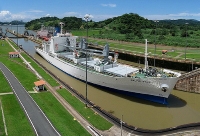
Way back in 1534, the enterprising King of Spain Charles V put forward the idea of building a shipping canal across the Central American isthmus to connect the Caribbean and Pacific Oceans. But it was not until 1880 that the French took up the challenge, fresh from their triumph with the Suez Canal. The French attempt proved disastrous, daunted by disease and the inhospitable conditions, which ended up claiming an estimated 22,000 lives before construction was abandoned in 1889. In 1904 the United States Government decided to give it a go, first setting to work to improve conditions for labourers, and on 15 August 1914, the cargo ship Anconbecame the first of hundreds of thousands of vessels to traverse the canal, which has been hailed as one of the greatest engineering wonders of the world.
Today control of the canal has been handed over to the Republic of Panama, and it is not only trading ships that undertake the eight-hour trip through the canal, avoiding the long and treacherous route around Cape Horn at the tip of South America. Among the 14,000 ships a year that pass through the canal are hundreds of cruise liners, carrying excited tourists, and pleasure boats from motor launches to ocean-going yachts. On the shore the canal provides a spectacle for thousands more tourists who flock to watch the ships pass by, making it one of the most popular attractions for those who holiday in cosmopolitan Panama City, from where the waterway stretches toward the Caribbean to the city of Colon.
The canal is made up of a series of locks and lakes, including the massive Lake Gatun, which was created by flooding acres of forest during construction. Another of the most spectacular parts of the canal is the Gaillard Cut, where labourers hacked their way through nine miles of solid rock. Cruising through the canal is a spectacular experience, more like sailing along a natural tropical river overhung with lush jungle foliage, than travelling along a man-made waterway.

Travel Guide powered by Word Travels, copyright © 2023 Globe Media Ltd. By its very nature information in this travel guide is subject to change at short notice and travellers are urged to verify information on which they're relying with the relevant authorities. Neither Globe Media Ltd nor Travel Vogue can accept any responsibility for any loss or inconvenience to any person as a result of information contained above.